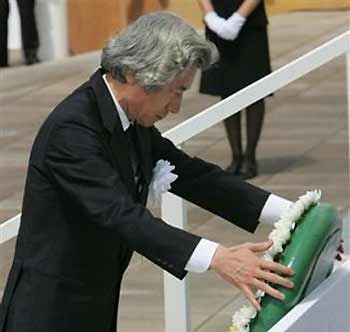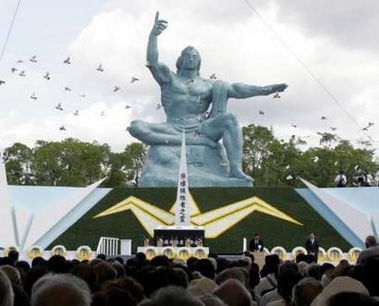|
Nagasaki marks A-bombing anniversary
(AP)
Updated: 2005-08-09 11:49
A siren wailed and a bronze bell rang out Tuesday as Nagasaki marked the moment 60 years ago when an American plane dropped a plutonium bomb, killing tens of thousands and sealing Japan's defeat in World War II, AP reported.
About 6,000 people, including hundreds of aging bomb survivors, crowded into Nagasaki's Peace Memorial Park, just a few hundred yards from the center of the blast, for a solemn remembrance and moment of silence.
When the silence ended, Nagasaki Mayor Iccho Itoh had some angry words for the leaders of the nuclear powers, and especially the United States.
"To the citizens of the United States of America: We understand your anger and anxiety over the memories of the horror of the 9/11 terrorist attacks," he said. "Yet, is your security enhanced by your government's policies of maintaining 10,000 nuclear weapons."

Japanese Prime Minister Junichiro Koizumi places a wreath during the ceremony to mark 60th anniversary of the atomic bomb attack in Nagasaki, southwestern Japan, Tuesday, Aug. 9, 2005. [AP] |
Itoh also urged Japan to get out from under the U.S. "nuclear umbrella." About 50,000 U.S. troops are deployed throughout Japan under a post World War II mutual security pact.
Prime Minister Junichiro Koizumi placed a wreath before the monument to the dead, and bowed deeply. "This is an occasion to remember the victims and pray for world peace," he said.
Tuesday's remembrances began just after sunrise, hundreds of Catholics joined in a special Mass at Urakami Cathedral, which at the time of the bombing was the largest in Asia with 12,000 parishioners — 8,500 of whom are believed to have been killed.
When the cloudy sky lit up in a sudden flash at 11:02 a.m. in 1945, two priests were hearing confessions inside the cathedral and 30 faithful were inside. Everyone in the church died and the statues around them turned black because of the intense heat.

Doves flutter around the Peace Statue in Nagasaki's Peace Park in Nagasaki, western Japan, during a ceremony commemorating the 60th anniversary of the city's atomic bomb blast August 9, 2005. [Reuters] |
Nagasaki was not the primary target in the U.S. military plans.
Three days after the Enola Gay dropped the "Little Boy" bomb on Hiroshima, killing at least 140,000 in the world's first atomic bomb attack, another plane took off to deliver the second A-bomb to the nearby city of Kokura.
Kokura was hidden under a thick cover of smoke. The plane circled three times, then changed course for Nagasaki, where it also encountered thick clouds.
With dwindling fuel, the pilot nearly turned around — but then the clouds broke. Japan surrendered on Aug. 15, 1945, ending World War II.
Nagasaki's devastation has been overshadowed by Hiroshima, where some 55,000 people swarmed into that city's Peace Memorial Park to mark the 60th anniversary of the attack last week.
The people here, however, have not forgotten.
"Together with some 260,000 A-bomb survivors ... I swear in the presence of the souls of the victims of the atomic bombing to continue to tirelessly demand that Nagasaki be the last A-bomb site," said Fumie Sakamoto, who represented the survivors at Tuesday's memorial. Sakamoto was a junior high school student when Nagasaki was bombed.
The remains of thousands of the dead have never been found. Japanese estimates of the death toll itself range from 60,000 to 80,000. Nagasaki officials on Tuesday used 74,000 as the death figure.
Throughout the worst-hit parts of town, thousands of colorful paper cranes, which are believed to ease the pain of the dead, were draped over stone monuments dedicated to the victims.
A steady stream of tourists also flowed into Nagasaki's A-bomb museum, where horrific reminders of the attack cover the walls; a broken clock with its twisted hands stopped at the instant of the blast, photos of the dead or the burned.
In sharp contrast with the museum at the controversial Yasukuni war shrine in Tokyo, which has been widely criticized as one-sided in favor of Japan's wartime leadership, the Nagasaki museum is careful to place the attack firmly in its historical context.
Visitors see a timeline of Japan's own military adventures, and exhibits note Tokyo's alliance with Nazi Germany. The final hall is taken up by appeals for the abolition of all nuclear weapons.
Other than the many small monuments around town, few signs of the devastation remain.
A scenic port city with a population of about 420,000, Nagasaki is today a popular tourist destination known for its Chinatown, one of the largest in Japan, and its vaguely European flair.
|